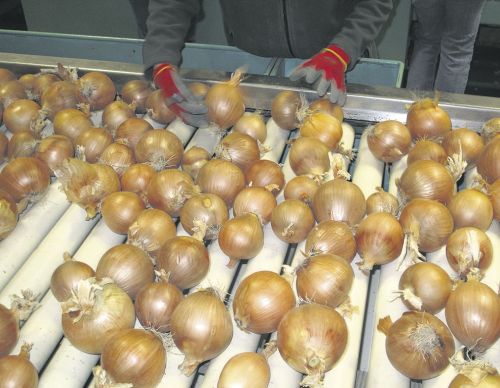Deadline nears for onion cull
Published 8:41 am Thursday, March 7, 2013

- Sean Ellis/Capital Press Onions are sorted at a facility in Ontario, Ore., last season.
Bulbs, debris must be disposed of by March 15 to prevent spread of maggots
By JOHN O’CONNELL
Trending
Capital Press
Onion growers in southwest Idaho and Malheur County, Ore., have until March 15 to dispose of their cull bulbs and debris through an approved method for preventing the spread of onion maggots.
Culls resulting from onions sorted after the deadline must be disposed of within seven days.
Mike Cooper, bureau chief with the Idaho State Department of Agriculture‘s Plant Industries division, said the state has imposed requirements for disposing of cull onions since the late 1980s to protect crops from damaging maggots lured by the stench of sprouting piles. Cooper said enforcement extends through July 1. In Idaho, the rules cover feedlots, packing sheds and fields in Ada, Canyon, Gem, Payette, Owyhee and Washington counties.
Cooper said ISDA rarely imposes the maximum $10,000 fine for violations and targets repeat offenders for hearings. He said warning letters are typically sufficient to correct a problem.
Many sheds dump cull onions in pits, covering them with an earthen cap angled for water drainage. Cull onions may also be fed to cattle, sheep and goats. Culls for composting must be buried under a foot of onion-free soil. Commercial fields where bulbs are left after harvest should be disked and plowed under 8 inches of soil. Culls may also be spread onto fields planned to be planted in a crop other than onions, disked and plowed beneath at least 8 inches of dirt. Culls should be treated with insecticides according to University of Idaho Agricultural Extension Service recommendations when bad weather delays proper disposal.
Trending
Ron Mio, a Fruitland, Idaho, onion grower, said ISDA has also conducted flyovers to make certain growers aren’t dumping culls in the hills.
“Without (the law) we’d probably have cull piles all over the place. It definitely helps on pests,” Mio said.
He said growers pay sheds an assessment for cull disposal.
Dave Larsen, with the onion-packing facility Fort Boise Produce in Parma, Idaho, said his business pools its culls with those of other sheds and disposes of them in pits on land used exclusively for cull disposal. This season, Larsen estimates a third of his facility’s culls have been buried in pits. The rest have either been chopped and frozen at a processing facility in Fruitland, which can utilize onions with nicks, or sent for cattle feed.
Some sheds’ culls are also processed into onion oil at a facility in Ontario, Ore.
Many sheds dumped good onions in cull pits or fed them to livestock just to free bin space last season due to low onion prices, around $2.50 per 50-pound sack. Larsen said prices are now around $12 per 50-pound sack. He’s noticed few remaining cull piles in onion country and expects some issues with rot will contribute to an average year for cull disposal.
“We’re still running (onions) out of storage. Some of it is really good, and with some of it there are some decay issues,” Larsen said.









